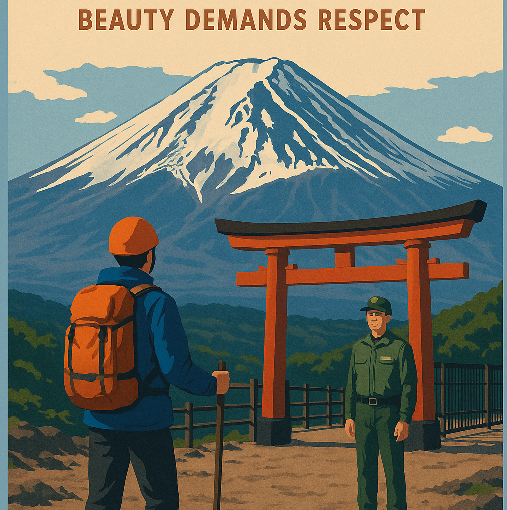
Jun 14, 2025
Mount Fuji, Japan’s iconic peak, has long captivated visitors from around the world. Its nearly perfect conical shape, often crowned with snow, is not only breathtaking but also deeply symbolic of Japan’s natural and spiritual beauty. For many, climbing Fuji is more than just a hike—it’s a bucket-list dream.
But while Mount Fuji looks serene and inviting from afar, it is still Japan’s tallest mountain, rising 3,776 meters above sea level. This majestic appearance can be deceiving. Unlike craggy or rugged peaks, Fuji’s smooth silhouette may give the false impression that it’s an easy climb. Every year, many tourists—some in casual sneakers or T-shirts—underestimate the challenge.
That’s why the Japanese government has taken new steps to protect both the mountain and its climbers. A new permanent gate has been completed at the 5th Station of the Yoshida Trail, one of the most popular routes. Designed to resemble a traditional torii gate, the structure is both functional and symbolic—a modern checkpoint echoing Japan’s respect for sacred spaces.
From July 1, when the official climbing season begins, the gate will help regulate the flow of climbers. It will be closed daily from 2 PM to 3 AM to reduce congestion and ensure safety. Hikers must now wear wristbands as proof of having paid the climbing fee and agreed to certain safety guidelines. Rangers will be stationed to offer advice and ensure everyone is properly prepared.
The message is simple: come prepared, both physically and mentally. Proper clothing, weather protection, and sufficient water and food are essential. But just as important is the mindset—an attitude of respect for the mountain, its unpredictable weather, and the local efforts to preserve it.
Climbing Mount Fuji is a powerful and unforgettable experience. With the right preparation, it becomes not only a personal triumph but also a tribute to the mountain itself. In return for its beauty, we owe Fuji our care, humility, and respect.
富士山登山:美しさには敬意が必要です
日本の象徴的な山、富士山は、長い間、世界中の訪問者を魅了してきました。そのほぼ完璧な円錐形の姿は、しばしば雪に覆われており、息をのむほど美しいだけでなく、日本の自然と精神的な美の象徴でもあります。多くの人にとって、富士登山は単なるハイキングではなく、「一生に一度は登ってみたい夢」です。
しかし、富士山は遠くから見ると穏やかで魅力的に見える一方で、実際には標高3,776メートル、日本で最も高い山です。この堂々とした見た目は、人を惑わせることがあります。ごつごつした山頂や険しい岩肌を持たないため、富士山は簡単に登れるという誤った印象を与えるかもしれません。毎年、多くの観光客が、カジュアルなスニーカーやTシャツ姿で、この挑戦を過小評価して登ってきます。
そのため、日本政府は、山と登山者の両方を守るために新たな対策を講じています。最も人気のある登山ルートのひとつ、吉田ルートの五合目には、新しい常設ゲートが完成しました。この構造物は、伝統的な鳥居を模したデザインで、機能的でありながら、日本の神聖な場所に対する敬意も表しています。
公式な登山シーズンが始まる7月1日から、このゲートは登山者の流れを管理する役割を果たします。毎日午後2時から翌朝3時まで閉鎖され、混雑の緩和と安全確保を図ります。登山者は、登山料を支払い、安全ガイドラインに同意した証としてリストバンドを着用しなければなりません。レンジャーたちが常駐し、アドバイスを提供し、登山者が適切な準備をしているかを確認します。
このメッセージは単純です:身体的にも精神的にも、しっかりと準備して来てください。適切な衣服、天候への備え、十分な水や食料は必須です。しかしそれと同じくらい大切なのは、心構えです——自然、予測不能な天候、そして富士山を守る地元の努力に対する敬意の気持ちです。
富士山を登るという体験は、力強く、忘れがたいものです。正しい準備をすれば、それは単なる自己達成ではなく、この美しい山への敬意を表す行為にもなります。その美しさに対して、私たちは思いやり、謙虚さ、そして敬意をもって応えるべきなのです。
